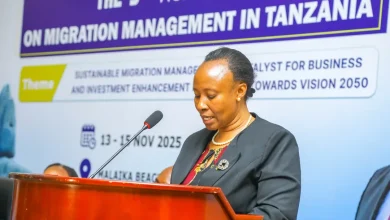Gen Z: Turning energy into opportunities

TANZANIA’S youth are at a historic crossroads. With over half of the population under the age of 25, the country is witnessing a demographic surge that holds immense promise for economic growth, social innovation, and civic participation.
Among these young people, Generation Z, simply those born between the mid-1990s and early 2010s-stands out for its digital fluency, social consciousness, and readiness to mobilize around issues that affect their communities. This generation is deeply connected, globally informed, and increasingly vocal, often expressing opinions and frustrations through social media platforms that amplify their reach.
Yet, the very traits that make Gen Z a powerful force for progress also carry risks when misdirected. Recent online conversations suggesting disruptive actions around December 9th highlight the urgent need for strategic leadership and practical engagement to guide youth energy toward constructive outcomes.
Understanding Gen Z is critical for effective intervention. Unlike previous generations, Tanzanian youth today navigate a world of constant connectivity, social media influence, and immediate access to information.
This environment has heightened their awareness of social justice, fairness, and governmental accountability, while simultaneously exposing them to misinformation, peer pressure, and narratives that glorify impulsive action. In urban and peri-urban areas, where mobile technology is nearly universal, the capacity for rapid mobilization is significant.
When young people feel excluded, unheard, or economically marginalized, the impulse to protest can quickly gain traction. While these actions may emerge from genuine grievances, the consequences that is both personal and societal are severe.
Arrests, criminal records, disruption of education or employment, and harm to communities are real risks. Furthermore, violent or chaotic action often undermines the very causes youth aim to advance, shifting public attention from grievances to destruction.
ALSO READ: TAHA rolls out Africa’s horticulture expo
The social and economic stakes of youth unrest are high. Riots or violent protests disrupt local economies, damage property, and erode community trust.
Small businesses, already vulnerable in tight-margin markets, often bear the brunt of looting or closures, and public perception can turn against the very movements youth intend to champion.
Beyond immediate costs, criminal records limit access to formal employment, scholarships, or business licenses, creating a cycle of frustration and social exclusion.
In a country striving for sustained economic development, such disruptions undermine both national progress and individual opportunity. Leaders, therefore, face a dual challenge: they must prevent unrest while simultaneously providing tangible, constructive alternatives for youth energy.
Providing meaningful alternatives is essential. Structured programmes that combine skills training, entrepreneurship, employment opportunities, and civic engagement offer youth pathways to tangible impact.
Vocational programmes provide practical skills aligned with market demand, from trades and logistics to digital services and agribusiness.
Entrepreneurship initiatives, such as Building a Better Tomorrow (BBT) (Tanzania) and similar platforms, equip young people with business skills, mentorship, and access to small grants, enabling them to launch micro-enterprises or social ventures.
Public works programmes and community-based initiatives offer immediate income while contributing to local development, including climate-resilient agriculture, infrastructure improvement, and environmental projects.
Digital freelancing programmes connect youth to remote income opportunities, building both financial independence and technological literacy. Together, these pathways transform idealistic energy into practical solutions that deliver social and economic benefits.
Consider Amina, a 22-year-old from Dar es Salaam. Initially frustrated by unemployment, she participated in a local entrepreneurship programme that offered mentorship, training, and a small grant to start a catering business.
Within six months, she began generating revenue, employed two peers, and contributed to her community. By sharing her story online, she inspired other young people to explore constructive alternatives to protest.
Stories like Amina’s illustrate how structured support can redirect potential unrest into entrepreneurship, innovation, and community development. Policymakers and influential leaders play a critical role in enabling these alternatives.
Coordinated interventions that combine vocational training, entrepreneurship support, public works, and digital engagement can provide tangible opportunities at scale.
Collaboration with industry partners ensures that training aligns with labor market needs, while mentorship programs guide youth toward responsible action.
Policymakers can incentivize private sector participation through tax benefits, facilitate youth-friendly business registration, and create public-private partnerships that expand employment opportunities.
By offering tangible pathways, leaders signal to youth that their concerns are being addressed constructively rather than being met solely with deterrence or enforcement. Practical implementation requires realistic planning, financing, and accountability.
For example, a three-year national initiative targeting 200,000 youth could allocate 80,000 participants to vocational programmes, 50,000 to entrepreneurship cohorts, 40,000 to public works, and 30,000 to digital freelancing programs.
Using conservative estimates—50 percent of vocational graduates securing paid work or internships within six months, 30 percent of entrepreneurs launching revenue-generating ventures, 70 percent of public works participants earning steady income, and 40 percent of digital freelancers achieving sustainable earnings— the initiative could generate more than 120,000 direct income opportunities.
These outcomes would range from temporary wages to ongoing business revenue and formal employment, substantially reducing the incentives for disruptive action. Blended financing approaches are essential. Public funds can seed and coordinate initiatives, private sector actors provide co-financing and job placement, and development partners fund capacity building and scaling.
Social impact bonds or pay-for-performance contracts ensure that financial support is linked to verifiable outcomes, such as jobs created or businesses launched. Impact investors and microfinance institutions can provide repayable capital for entrepreneurship cohorts, while diaspora funds and corporate social responsibility initiatives supplement grants and seed funding.
Transparent monitoring and evaluation systems, combined with digital tracking of participants, ensure accountability and allow rapid course correction when necessary.
Execution strategies must be both practical and youth-centered. Programmes should embed mentorship, peer support networks, and digital platforms for tracking progress and opportunity matching.
Geographic targeting ensures programs address the needs of urban, peri-urban, and rural youth appropriately. Legal support, psychosocial guidance, and safeguards against exploitation further reinforce trust and engagement.
Communication is equally important: young people must understand that the state and community leaders are providing real, attainable opportunities, and that responsible action can yield recognition, income, and social influence. Expanding the narrative to include economic and social context underscores the stakes. Youth unrest affects not only participants but also the broader economy, investor confidence, and community cohesion.
Conversely, constructive engagement enhances social stability, fosters innovation, and strengthens trust between young people and institutions. By creating clear pathways to income and influence, policymakers and stakeholders can prevent unrest while cultivating a generation of skilled, engaged, and productive citizens. Ultimately, they will respond to opportunity, dignity, and measurable impact.
Programmes that provide skills, entrepreneurship support, civic engagement platforms, and income-generating opportunities demonstrate that alternative pathways are achievable. Leaders who invest in scalable, accountable initiatives can transform potential unrest into creativity, enterprise, and civic participation. The choice is strategic: channel youth energy into enterprise, dialogue, and innovation, and harness it to drive both personal and national development.
The stakes are high, but the opportunity is extraordinary. By investing in structured programmes, mentorship, employment pipelines, and digital engagement, Tanzania can ensure that its youth become drivers of sustainable growth rather than sources of disruption.
The actions of policymakers, community leaders, and influencers today will determine whether this generation’s energy is a catalyst for national progress or a potential source of unrest. Guiding youth responsibly, providing tangible opportunities, and communicating effectively are not just preventive measures—they are proactive investments in the country’s future.
When Generation Z sees that constructive avenues exist for influence, income, and personal growth, the impulse for disruptive action diminishes, replaced by ambition, innovation, and productive engagement.
Tanzania’s youth are a national treasure whose potential must be harnessed carefully and thoughtfully. By combining policy vision, practical program design, and community engagement, leaders can create a framework in which youth energy translates into entrepreneurship, employment, civic participation, and social cohesion.
The dual responsibility is clear: youth must take initiative, but leaders and influencers must provide the structures, resources, and guidance to ensure that ambition leads to opportunity rather than risk. By doing so, Tanzania can transform a demographic challenge into a historic opportunity, securing both the future of its young citizens and the longterm prosperity of the nation.





